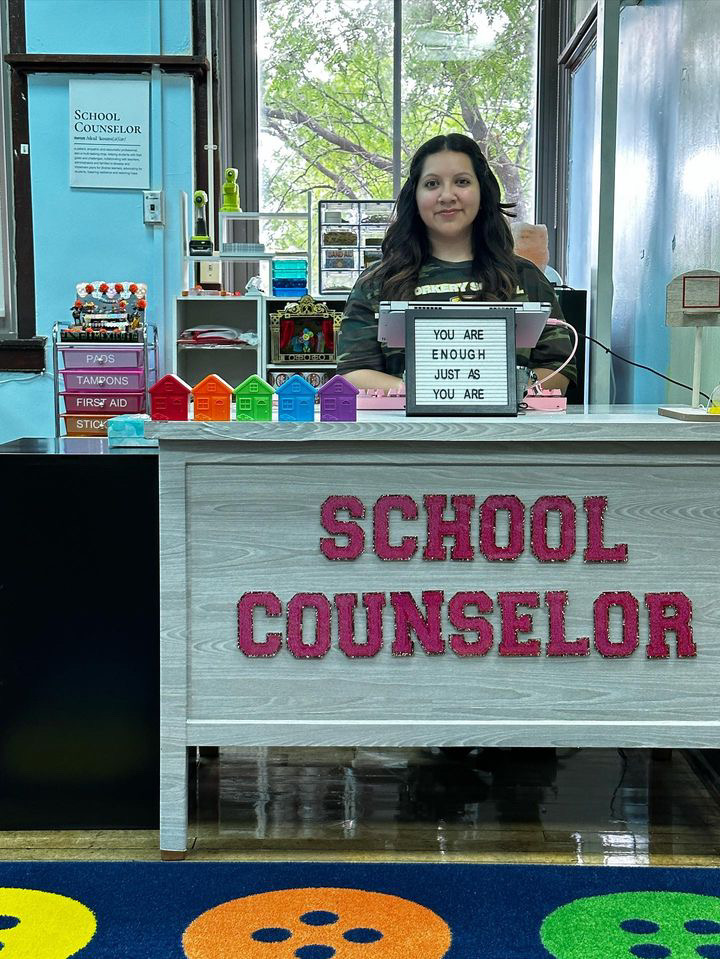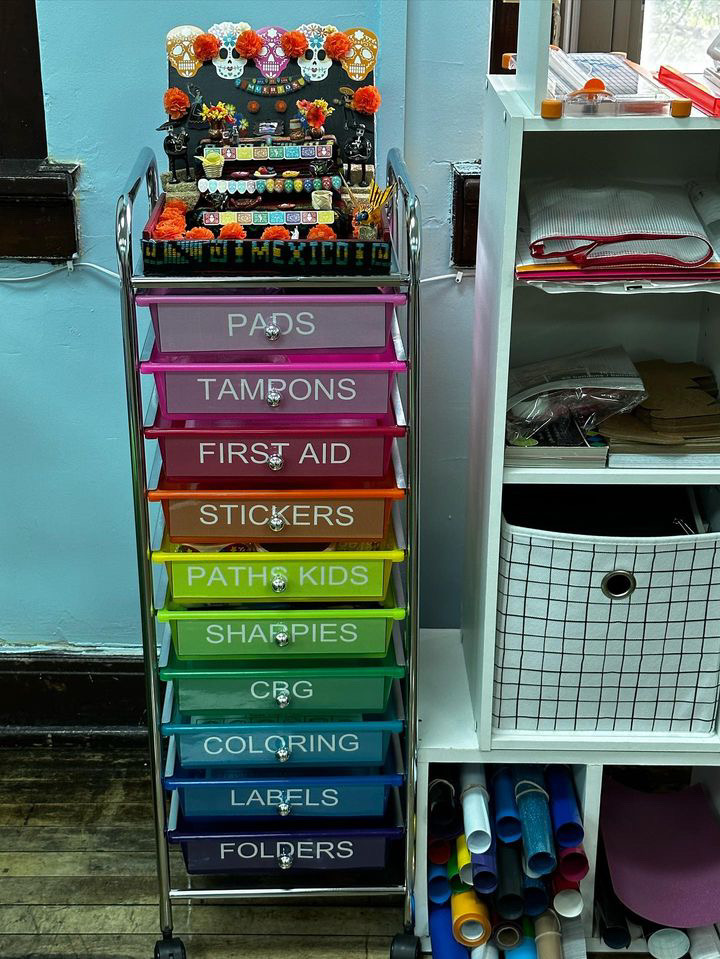“Ms. V., do you have a sanitary napkin?”
This is a common question Mai Villasenor hears throughout the school year. Whether it’s in class, where she supports her assigned students as a special education classroom assistant (SECA), or during one of the extracurricular activities she sponsors, like the Filipino American Club, Villasenor finds herself discreetly passing period products to students.
On the days when she isn’t carrying a menstrual pad herself, she directs students to one of Lane Tech College Prep’s restrooms, but they aren’t always stocked. The main office serves as the schools most trusted source for students’ menstrual needs.
“You can always find them in the main office. But who thinks to go to the main office for a pad?” she asks.
Villasenor is a former Chicago Public Schools (CPS) student herself and remembers machines installed on the bathroom walls of Lincoln Park High School that required quarters to dispense tampons. She graduated before state law required all public schools to provide these products for free.
According to CPS, the district began providing free period products to students in 2019, when the Learn with Dignity Act first went into effect. CPS’ policy states that all schools serving grades 3-12 must make menstrual hygiene products available, at no cost to students, in bathrooms of every school building. The way that this has been implemented looks different in schools across the city.
What is menstrual equity?
Earlier this year, IL Latino News looked into the laws that support menstrual equity in Illinois.
Menstrual equity, or period equity, as first defined by Jennifer Weiss-Wolf, co-founder of Period Equity, refers to the affordability, accessibility and safety of menstrual products for all people, including laws and policies that acknowledge and consider menstruation. Weiss-Wolf first coined the term in a 2015 Cosmopolitan article about ending the tampon tax, which many consider to have catapulted the menstrual equity movement forward. The term has since expanded, with many organizations now including education about menstruation and reproductive care in the definition.
According to Obstetrics & Gynecology, 64% of women reported having difficulty affording pads or tampons. Laws like the Learn with Dignity Act work to ensure menstrual equity by providing access to these essential health products, which many cannot afford.
This is especially important in districts like CPS where 73% of students come from low-income households, and 82% of students are Hispanic or African American.
Rep. Barbara Hernandez, who’s sponsored several bills expanding access to free products, says that many people have a misconception of who period poverty impacts.
“They never really think about it happening right here in your hometown, in your country. It’s very important to just take a step back and actually see that it is happening in our community and it’s happening in our low income households,” she said.
Products outside of restrooms create additional barriers
According to staff members in some schools, products are not always as easily accessible as the policy implies.
At Corkery Elementary School, counselor Giovanna Cruz keeps products stocked in her classroom, something she started doing after conversations with students made her realize the inconvenience they faced if they forgot a pad or tampon at home – or if their families couldn’t afford products.


“They felt really uncomfortable,” Cruz explained. “We do have them, but they’re just in the office.”
The main office of Corkery sits on the ground floor, where there are no classrooms.
Fifth and sixth grade classrooms at the school are on the top floor, which leaves menstruating students who need a product traveling down three floors, walking over to the office, then back up to the top, stopping in a restroom along the way.
“You can’t just say ‘I need to go to the bathroom,’ because the teachers know how long it takes you to go to the bathroom. So you have to be specific and then you know, you have to raise your hand and be like, ‘can I go to the office to get [a pad]. It’s just…” Cruz said, her voice trailing off as she shook her head.
At Lane Tech, Villasenor says that products kept in the restrooms aren’t consistently restocked.
“We can always find the napkins, but rarely ever the tampons in the main bathrooms,” she said, leaving students who need a period product to check in the next nearest bathroom, or walk to the main office. This feat isn’t easy on Lane Tech’s massive campus. It is the largest school in the city, consisting of 607,000 square feet – which students have 5 minutes to navigate during passing periods.
Damaris Pereda, the National Programs Director of PERIOD. says that keeping products stored in the main office or a nurse’s office creates additional barriers and more time that students are not in class.
“They have to go to the restroom first to visually realize that they might need [a product], then they need to go to another office,” said Pereda. “All of that is time that they are not in school or school activity, which is impacting their academic outcome.”
Students miss school when they don’t have products
“I did have a student, a sixth grade student who would refuse to come to school during her period,” said Cruz.
This isn’t uncommon. The 2021 “State of the Period” national survey found that 4 in 5 teens have either missed class time or know a classmate who missed class time because they did not have access to period products.
Periods typically last three to seven days, which means a student missing school due to not having hygiene products is missing a significant amount of learning time. A student who misses 10% of days in a school year –whether excused or not– is considered chronically absent. In CPS, this is 18 school days.
Studies show that chronic absenteeism has negative impacts on both grades and standardized test scores, which is especially concerning given that students are already academically behind due to the pandemic.
Sparking conversations about accessibility
Cruz says her students have expressed shame and embarrassment around having to ask for pads in the office.
“I feel for them,” said Cruz, who purchases the products she provides to students out-of-pocket. “It’s easier to be like, ‘can I go to the counselor’s office?’ Instead of saying ‘can I go to the main office?’”
She says that the same students tend to cycle back to her office every month looking for pads, which she doesn’t mind providing.
“It really just got me thinking of what are other ways that we can supply them in the school? What other conversations can we have?”
_________________________________________________________________________
Publisher’s note: ILLN is committed to covering period poverty and menstrual equity in Illinois. This reporting is supported by a fellowship with the Journalism & Women Symposium (JAWS).




